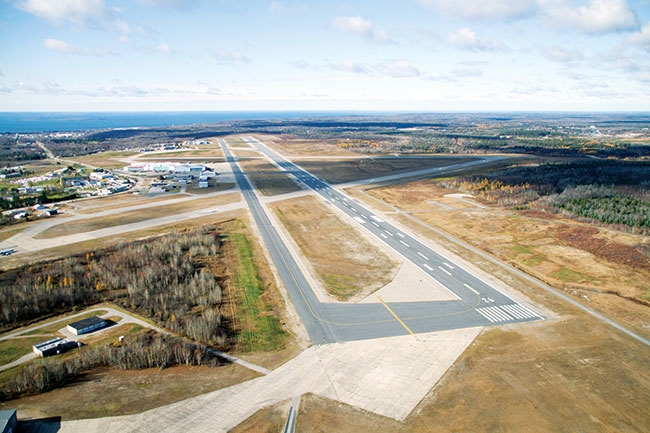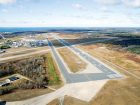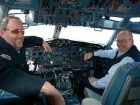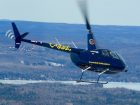
News
Fitting the pieces together
"Punching above its weight. Open for business. Finding just the right niché to build on a strong foundation.”
April 28, 2017 By Matt Nicholls
 North Bay has invested more than $30 million in its airport in the past decade. Punching above its weight.
North Bay has invested more than $30 million in its airport in the past decade. Punching above its weight.Poignant expressions all and certainly accurate ones to describe the city of North Bay’s aerospace footprint – a developing infrastructure with strong ties to the past striving towards an even brighter future.
Located some 344 kilometres north of the GTA and centrally located between Sault Ste. Marie to the west and Ottawa to the east, this vibrant northern city of some 51,000-plus located on the shores of Lake Nipissing has one of the most diverse economies of Ontario’s northern communities – and a very rich aerospace history to boot.
Much of that history is connected to the Royal Canadian Air Force (RCAF). Since the 1930s, North Bay has served as a strategic location for the RCAF as home to both 22 Wing North Bay and its 21 Aerospace Control and Warning Squadron.
The city’s military footprint is extensive and has grown from its initial use as an emergency landing field in 1933 to playing key roles in both the Second World War ferrying Liberator and Lancaster Bombers across the Atlantic to Europe. It also played critical roles during the outbreak of the Korean War before transforming into the main nerve centre for NORAD.
In October 2006, Canadian NORAD Region air defence operations moved out of its Underground Complex into a new state-of-the-art installation named the Sgt David L. Pitcher Building, after a Canadian serviceman who was killed in the crash of a U.S. Air Force AWACS patrol plane in 1995.
The new $16 million command centre was built above ground and the complex proudly continues its role as one the most important air bases in Canada, responsible for the air defence of the nation almost half of the North American continent.
In 2010, CFB North Bay’s operations centre took the first steps towards transitioning from air to aerospace defence, commencing preparations for Sapphire, Canada’s first military satellite. CFB North Bay commenced surveillance of space via Sapphire, Canada’s first military satellite that was launched into orbit from India in February 2013. Today, Sapphire is performing surveillance of objects orbiting at 6,000 to 40,000 kilometres altitude, and delivering data on those objects to the Space Surveillance Operations Centre (SSOC) in North Bay’s operations centre.
In 2014, the Government of Canada awarded a contract to Raytheon Canada Ltd. for the operation and maintenance of the North Warning System. The North Warning System is comprised of 47 unmanned long- and short-range radar stations along the Arctic coast from Alaska to Labrador.
The North Warning System is used to ensure Canadian sovereignty in the North and to support North American air surveillance and air defence operations under the North American Aerospace Defense Command (NORAD) agreement.
Connecting the dots
North Bay’s military footprint past and present is a strong one, yet the future of its aerospace footprint lies in attracting new and diverse commercial and business partners to its hub around Jack Garland Airport.
Located minutes from the downtown core and situated around acres of wide open green space, the airport is served by regional, international and charter operators including Air Canada, Porter Airlines, Bearskin Airlines, Jazz Aviation LP and Sunwing. The city has invested more than $30 million in the past decade to upgrade the airport and surrounding lands, making it a prime spot for aerospace companies looking to expand and grow.
With its 10,000 ft. runway, ample room for hangar space, MRO capabilities, fully-serviced parcels with full water and sewer connections, power, fibre-optic network access and competitive land values and incentives to offset development and operation costs, it’s a prime spot for international and domestic aerospace companies to call home.
Rotary- and fixed-wing aviation training on both the flight and maintenance engineering sides of the equation are a true hallmark of the city’s aerospace footprint, with a variety of options available to aspiring students. The airport is home to some of the most respected training schools in the province, with Canadore College’s School of Aviation, Helicopters Canada Flight Training and Charter and Essential Helicopters all calling Jack Garland home.
Other key aerospace players dot the site including Voyageur Aviation Corp. (Chorus) the Ministry of Natural Resources and Forestry (MNRF) – opening its new $9.5 million state-of-the-art Fire Response Facility this year – and Comsatec Inc., an energy management firm based in Callander, Ont. and Toronto.
With some 48,000-plus aircraft movements last year, the airport is a bustling spot with a diverse mix of aircraft and operations according to Jack Santerre, the airport manager at Jack Garland. Santerre recently took Wings on a tour of the airport and the surrounding property.
“We have a diverse mix of aircraft traffic in North Bay,” Santerre told Wings . “There is the commercial traffic, the schools. Bombardier also comes up to do their testing for the C Series, the Q400s. We also see a fair amount of military traffic, although we are not a military airport. We get every thing from Hercs to Challengers to Griffons to C-17s.”
A heavy-lift and de-icing exercise with an IL76 was also on the dance card for our tour, but was postponed at the last minute. Heavy-lift opportunities to far north mining operations are another potential area of growth for the city.
Also enhancing traffic in the future will be the OMNR’s new fire fighting response facility, which will feature a state-of-the-art 1,149 sq. metre Fire Management Headquarters that will have dedicated aircraft parking for two CL-415 water bombers, two bird-dog aircraft and two helicopters.
“Anyone who had been here five years ago probably would have looked at me and said, ‘what the heck has happened here?’ ” noted Santerre. “We just finished developing our west end industrial park and all of it is serviced land, ready to go. Basically, there’s no hindrance for the master plan of the airport. The next phases are already lined up.”
Erin Richmond, manager of economic development for the City of North Bay underscores the progress that is being made, acknowledging that ironclad partnerships between industry and the city and ease of operations are drawing cards that should foster growth.
“One of the things we do at the city to help stimulate development,” Richmond said,” is our DART team, which is a development application review team. Any new development project that we encounter for the city, the DART team gets involved. The team is made up of representatives of everyone involved – economic development along with outside agencies such as the MTO and the Convervation Authority. Everyone comes together and reviews each application so new tenants don’t have to knock on 20 doors to get information. It’s a one-stop shop.”
Santerre is on the team and is impressed with the way community partners work in unison. “The City of North Bay as a whole is a very strong supporter of the aviation community,” he said. “The city realizes the importance of an airport and how it helps drive the economy in the community. Airports are not only transportation hubs, but they are catalysts for economic development and growth.”
It also doesn’t hurt to have a mayor that lives and breathes aerospace – it’s in his blood. Mayor Al McDonald’s father was an RCAF pilot who was stationed all over Canada in a variety of roles. He shared some of his adventures and visions for North Bay’s aerospace future with Wings during a lunch break on our tour.
“From a North Bay perspective, I think we have a great opportunity here,” McDonald said. “But it is about political will – it is putting a lot of time and effort into developing it. We have all the pieces here, it’s just how do you give it even more attention.”
Educational building blocks
One of the pieces firmly in place in North Bay is its educational offerings for aspiring aviation students. Canadore College School of Aviation is one the most respected colleges in Ontario, offering students a diverse mix of academic programs in fixed- and rotary-wing operations. From flight training at partner Essential Helicopters to one of the college’s structural, mechanical, avionic and composite repair and engineering programs, the college has a solid reputation throughout the industry.
A tour of the bright, inviting campus reveals not only a high competency level of academic proficiency, but an equally high level of commitment, dedication and passion from its instructors, ensuring students are properly and effectively prepared for future industry roles.
The college prides itself on its 15-1 student to professor ratio and is equally proud of the fact its instructors – most active in the field themselves – bring hundreds of years of practical experience to their roles in a variety of engineering and maintenance fields. It is also basking in the glow of a new multi-million dollar composites wing and a $400,000 boost to its avionics program.
“I find it amazing how well we are punching above our weight,” noted Martin Galvin, dean of aviation, business and liberal studies. “We are not putting out as many graduates as the others in Ontario, but we have so many graduates that are making a difference in the industry.
Part of this “difference” is most certainly because of passionate instructors who ensure the teaching methodologies closely replicate those of industry. It’s all about supplying operators with young professionals that are skilled, professional and adaptable to handle a variety of challenges.
Getting in the spin
Aspiring helicopter pilots hoping to make their mark in the rotary world have two strong options in Helicopters Canada Flight Training and Charter and Essential Helicopters. Both offer students intimate hands-on class instruction from experienced, industry-respected pilots. Current industry trends in forestry, mining and aerospace have created increased demand for both helicopter charters and qualified rotary pilots.
Founded in 2000, Helicopters Canada has experienced steady growth with a fleet of six helicopters, delivering internationally recognized flight training programs. Programming includes commercial licencing, private licencing, foreign conversions, night rating, helicopter type ratings and more.
Training at Helicopters Canada aims to prepare students for the realities and skills required in the industry. The students build their time learning advanced flying techniques, which can include short- or long-line slinging, hover exit and water bucketing. It is not uncommon for students to graduate with five to 10 hours of solo slinging, which they can practise in the training fleet.
“The world-class training program at Helicopters Canada attracts students from around the world who are seeking a high level of expertise, and the unparalled training environment North Bay provides,” Shana Sullivan, president of Helicopters Canada Flight Training and Charter said. “We train students to get a licence, but also train the skills employers are looking for.”
Essential Helicopters offers a variety of helicopter training services that includes flight training, charter and maintenance. Essential has partnered with Canadore College to provide a one-of-a-kind College Pilot Preparedness Certificate program in commercial helicopter pilot training, the only flight training program of its kind in Canada.
With a fleet of six aircraft including Jet Rangers, R22s and R44s, the intimate classroom settings at Essential’s home base enable students the flexibility to pick their program for total of 100 hours – they can mix it up based on their budget and what they desire. Essential has also a new fixed-wing program for students that have designs on a career on the fixed-wing side of the business.
Essential’s educational programs on the rotary side also include training in many of the soft skills students will need in real world situations: for example, learning to use a chain saw to build a heli pad, first aid, all aspects of base development, aircraft scheduling, egress training and more.
“We have a lot of chief pilots come in and speak to the students,” Elaine Ross, Essential’s administrator and student coordinator told Wings. “We also do a course that gives them a strong understanding of what to expect in the real world.
A look to the future
With its rich aerospace history, foundation of key pieces in place, busy airport and a strong cohesive network of industry partners working in unison with city to drive business, North Bay is certainly not starting at the bottom – and it’s open for business and working its way up. Establishing a key nichés that set it apart is one of the goals going forward.
And whether that’s providing support for the city’s strong mining supply and service sector – the possibility of airships perhaps? – unmanned aerial vehicle (UAV) testing in the vast green space that surrounds the airport or BizAv growth, the city is working hard to entice new players to venture north.
“I explain it this way in business,” McDonald said. “Let’s say, you walk into a grocery store and you see a can of Coke, Pepsi, and RC Cola (with RC being North Bay). Even though RC might be better than Pepsi and Coke, you probably will pick Pepsi or Coke. What we need to be able to do is to get people to pick RC – because people just don’t see us for what we offer right now. If you were trying to put the whole puzzle together, I think we have all the pieces right. Now, we just need to try to inform people of what we have.”



